The former pupils, and one staff member, of Aberaeron Secondary School who fell during both World Wars are commemorated on two memorials within the school. The Great War Memorial, in the form of an oak memorial tablet, was carved by Joseph Reubens, of Highmead, who was a Belgian refugee during the war, and returned to Bruges after the armistice.
World War One, 1914-1918
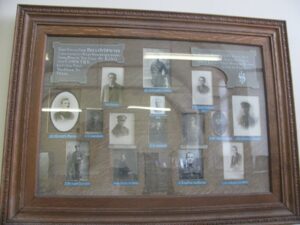
Albert Gordon Davies, MC, Second Lieutenant, Royal Welsh Fusiliers. Albert was born at Aberaeron in 1889, the son of John and Elizabeth Alban Davies, of Tanyfron Villa. He was commissioned into the 7th Battalion (Merioneth & Montgomery), Royal Welsh Fusiliers during 1916, but was subsequently attached to another battalion in France. Albert was probably wounded at Messines in 1917, during an action which led to him being awarded the Military Cross. His citation, which was published in the London Gazette of 25 August 1917, read; For conspicuous gallantry and devotion to duty. During an attack in complete darkness, he pushed through our own barrage to the enemy line in order to restore the direction which his platoon had lost, afterwards leading them to their objective. He displayed magnificent gallantry throughout. Sadly Albert died of his wounds at Bailleul on 1 August 1917, aged 27. He is buried at Bailleul Communal Cemetery Extension, France.
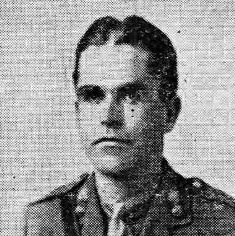
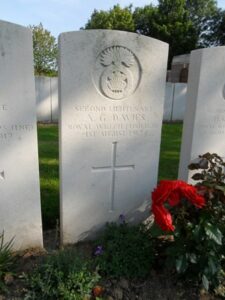
Daniel Meurig Davies, MM, Private, 91673, Durham Light Infantry. Daniel was the son of David and Margaret Davies, of Taincwm, Gartheli, Felinfach. He was senior scholar of St. John’s College School, Ystrad Meurig prior to the war, and enlisted at Aberystwyth on 23 December 1916 into the Pembroke Yeomanry. After four months on the reserve, Daniel was posted to the Welsh Regiment, before being drafted to France in April 1918, and joining the 15th Battalion, Durham Light Infantry, which was attached to 64 Brigade, 21st Division. The division was one of the units hit by the German Spring Offensive on the Somme in March 1918, fighting at the Battle of St Quentin and the First Battle of Bapaume, before being evacuated to Flanders to rest. Unluckily though, the Germans launched a fresh offensive on the Lys in April 1918, and the division was caught up in the thick of the fighting again. The battered division now moved south to rebuild, but again was unlucky, as the Germans launched a fresh offensive on the Chemin-des-Dames, and the division was caught up in the action again, fighting in the Battle of the Aisne. During August 1918 onwards the Division they took part in the great offensive which ended the war. Daniel was wounded during the Battle of the St Quentin Canal, and was evacuated to the 65th Field Ambulance, where he died of his wounds on 6 October 1918, aged 19. Daniel is buried at Fins New British Cemetery, Sorel-Le-Grand, France. He had won the Military Medal prior to his death.
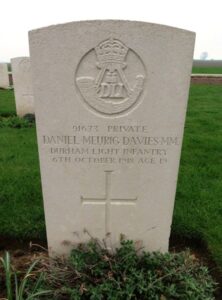
David Ernest Davies, Ordinary Seaman, Wales Z/5376, Royal Naval Volunteer Reserve. David was born on 22 October 1894, the son of David Davies, of Lloyd Jack, Felinfach. He served with the Royal Navy at the R.N. Depot, Crystal Palace. David became ill towards the end of the war, and died on 13 October 1918. He was 23 years old, and is buried at Llanfihangel Ystrad (St. Michael) Churchyard.
Evan James Davies, Second Lieutenant, Welsh Guards. Evan was probably born in 1900, the son of Roderick and Mary Davies, of Gartheli. The family later moved to London, and Evan enlisted there into the 28th Battalion, London Regiment (Artists Rifles) OTC. He was commissioned into the 1st Battalion, Welsh Guards, and served with them in France from 3 October 1917. The Welsh Guards were attached to the 3rd Guards Brigade, Guards Division, and Evan would have taken part in the Battle of Cambrai soon after joining them. They remained in the area over the final winter of the war, and were stationed near Gouzeaucourt when the German Spring Offensive hit the area on 21 March 1918, at the Battle of St Quentin. On the night of 27 March 1918, the Welsh Guards moved into the front line to relieve the 1st Battalion, Grenadier Guards, at Boyelles. On the following morning, 28 March 1918, the Germans launched a fresh assault on the Welsh Guards positions, and it was whilst trying to repel this attack that Evan was killed. He is commemorated on the Arras Memorial, France.
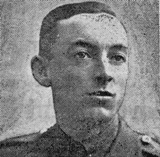
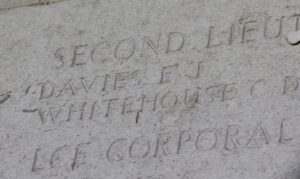
Evan Walter Davies, Second Lieutenant, Royal Welsh Fusiliers. Evan was the son of Walter and Dinah Davies, of Pantmarchog, Cribyn. He served as a Squadron Quartermaster Sergeant at the outbreak of war with the Pembroke Yeomanry, and whilst the Pembroke Yeomanry were readying to move to Egypt, Evan was commissioned as a Second Lieutenant. On 15 March 1916 Evan reached Egypt with the Yeomanry, and was transferred to the 1/7th Battalion (Merioneth & Montgomery), Royal Welsh Fusiliers, which was in Egypt attached to 158 Brigade, 53rd (Welsh) Division. The Division had fought at Gallipoli the previous year, and spent all of 1916 on garrison duty on the Suez Canal. In March 1917 the British advanced across the canal into Palestine, and took part in their first engagement here on 26 March 1917, at the First Battle of Gaza. Evan was killed in action that day, He was 23 years old, and is buried at Gaza War Cemetery, Israel.
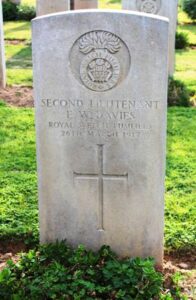
John Penry Davies, Private, 54123, Welsh Regiment. John was the son of Tom and Kate Davies, of Emrys House, New Quay. He enlisted at Cardigan into the 4th Battalion, Welsh Regiment, and had fought with the battalion at Gallipoli in August 1915, where it was attached to the 53rd (Welsh) Division. John was wounded at Gallipoli, and was invalided home. Upon recovery, he was posted to the 18th Battalion, Welsh Regiment, which was attached to 119 Brigade, 40th (Bantam) Division. The Division moved to France during the first week of June 1916, and moved to the front near Loos. Late in 1916 they moved south to the Somme, and fought at the Battle of the Ancre, and remained in the area over the winter. In March 1917 the Germans withdrew to their shortened line, called the Hindenburg Line, and the 40th Division were one of the Divisions that followed the withdrawal. John was wounded during the advance, and died of his wounds on 21 April 1917, aged 20. John is buried at Bray Military Cemetery, France.
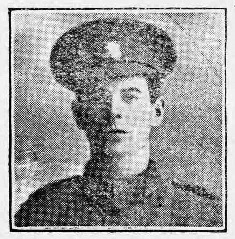
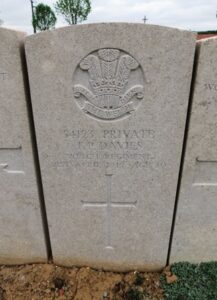
Thomas Davies, Private, G/40115, Middlesex Regiment. Thomas was the son of Charles and Mary Davies, of Penbryn Farm, Cribyn. He was a Bank Clerk prior to the war, and enlisted into the Royal Fusiliers at Builth Wells, and was posted to France on 31 August 1916, where he joined the 12th Battalion, Middlesex Regiment, which was attached to 54 Brigade, 18th (Eastern) Division. The Division was on the Somme, after having taken part in the Battle of Albert. They then fought at the Battle of Bazentin, where they captured Trones Wood, and moved on to the Battle of Delville Wood. In October they took part in the Battle of the Ancre Heights, capturing Schwaben Redoubt, and helped capture Regina Trench. Thomas was wounded on 27 October 1916, and was evacuated via No 12 Canadian Field Ambulance to No 11 Casualty Clearing Station where he died that same day. Thomas was 27 years old, and is buried at Varennes Military Cemetery, France.
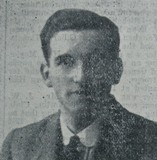
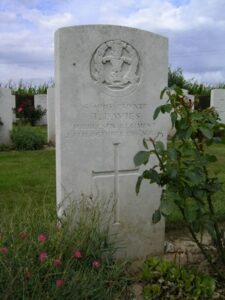
William Thomas Howell Davies, Corporal, 21820, Royal Welsh Fusiliers. William was the son of David and Rachel Davies, of The Post Office, Felinfach. William enlisted at Aberystwyth into the Royal Welsh Fusiliers, and was posted to Colwyn Bay, where he joined the 15th Battalion, Royal Welsh Fusiliers. The battalion moved to Winchester in the summer of 1915, attached to 113 Brigade, 38th (Welsh) Division. The Division had landed in France during December 1915 and had spent their first winter in the trenches near Armentieres. In June they marched south to the Somme, where they were tasked with the capture of Mametz Wood. The attack on the wood began on 7 July, but met with fierce resistance, and it took until 14 July to totally clear the wood. William was killed in action at Mametz Wood on 11 July 1916. He was 26 years old, and is commemorated on the Thiepval Memorial, France. His brother John also fell.
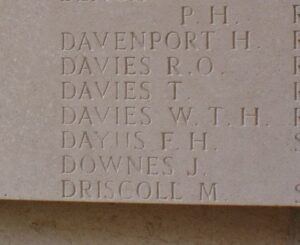
John Lloyd Evans, Second Engineer, Mercantile Marine. John was born in 1898, the son of Mary Evans, of Morfagwyn, New Quay. He served with the Mercantile Marine aboard the SS Sandsend, a West Hartlepool registered Collier. On 16 September 1917, Sandsend was on voyage from Barry to Queenstown with a cargo of coal and general cargo, when struck a mine which had been laid by the German submarine UC-48, and sunk with the loss of three lives. John was 25 years old when he died that day, and is commemorated on the Tower Hill Memorial, London.
Daniel Harold Jenkins, Guardsman, 1427, Welsh Guards. Daniel was the son of David and Elizabeth Jenkins, of Millet Park, Llanon. He enlisted at Cardiff into the 1st Battalion, Welsh Guards. The Regiment was raised by Royal Warrant of 26 February 1915, at White City, before landing at Le Havre on 18 August 1915, becoming attached to 3rd Guards Brigade, Guards Division. The Division saw its first major action during the Battle of Loos on 25 September 1915, remaining in the area during the coming months, where they also fought in the subsequent Action of Hohenzollern Redoubt. In July 1916 the Division moved to the Somme, where they fought at the Battle of Flers-Courcelette, and then at the Battle of Morval, capturing Lesboeufs Village. They remained here for the winter, and in March 1917 followed the German Retreat to the Hindenburg Line. Later that year they moved north to Ypres, where they fought at the Battle of Pilkem Ridge, and then at the Battle of the Menin Road, Battle of Poelcapelle and the First Battle of Passchendaele. November saw them move south again, where they took part in the Battle of Cambrai. They remained in the area over the final winter of the war, and were stationed near Gouzeaucourt when the German Spring Offensive hit the area on 21 March 1918, at the Battle of St Quentin. Daniel was killed on the Somme on 27 May 1918. He was 30 years old, and is buried at Bienvillers Military Cemetery, France.
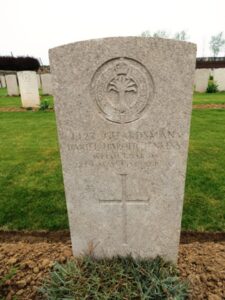
David Jones, Lieutenant, South Wales Borderers. David was the son of David and Sarah Jones, of Dolau, Dihewid, Felinfach. David had been educated at Carmarthen College before taking up a post as assistant teacher at Cwrtnewydd School prior to the war. He was commissioned into the 3rd Battalion, South Wales Borderers. Soon after being commissioned, David was posted to the 1st Battalion, King’s Shropshire Light Infantry, which was attached to 3 Brigade, 1st Division, probably joining the battalion in time to take part in the Third Battle of Ypres. The Division was near Estaires when the German Spring Offensive caught them in April 1918, and the Division took part in a fighting retreat, through the Battles of Estaires, Hazebrouck, and Bethune. David was killed at Ypres by a bomb, during a quieter spell in the trenches, on 24 July 1918. He was 28 years old, and is buried at Abeele Aerodrome Military Cemetery, Belgium.
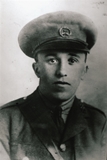
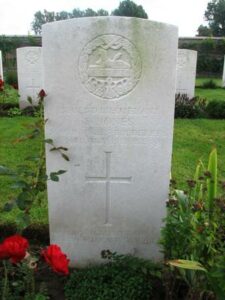
Evan Lewis Jones, Second Lieutenant, Machine Gun Corps. Evan was the son of Benjamin and Elizabeth Jones, of Gofynachfawr, Llanarth. He was commissioned early in 1916 into the 10th Battalion, North Staffordshire Regiment. Evan was then attached to the 76th Brigade, Machine Gun Corps, which was attached to the 3rd Division. One of the first formations in France, the 3rd Division was still at Ypres early in 1916, where it fought at the Actions of the Bluff, and at the St Eloi Craters. They were then moved south to the Somme, and fought there at the Battle of Albert, and the Battle of Bazentin, where they captured Longueval. They then took part in the Battle of Delville Wood. The next major action for the Division was during the Battle of the Ancre, and it was here, on 13 November 1916, that Evan was killed. He was 24 years old, and is buried at Bertrancourt Military Cemetery, France.
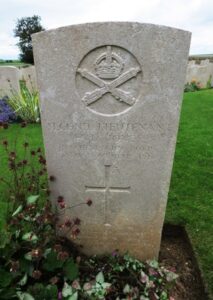
Ivor Jenkin Jones, Private, 37532, Royal Welsh Fusiliers. Ivor was the son of John and Margaret Jones, of Penwern Farm, Cilcennin. He worked as a clerk in The National Provincial Bank at Aberdovey prior to the war and enlisted there into the Royal Welsh Fusiliers on 18 December 1915. Ivor was posted to France 25 June 1916, joining the 16th Battalion, Royal Welsh Fusiliers. The battalion was attached to 115 Brigade, 38th (Welsh) Division, and Ivor joined up with them in time to take part in the attack on Mametz Wood. After suffering heavy casualties at Mametz, by August 1916 the Division had moved to positions at Boesinghe, north of Ypres. Ivor was shot in the shoulder here on 29 July 1917, when his battalion was moving into positions ready for the assault on Pilckem Ridge. He was evacuated home for treatment, before being sent back to France in January 1918, when he was posted to the 2nd Battalion, Royal Welsh Fusiliers. The battalion had taken part in almost every major action of the war, before becoming attached to 115 Brigade, 38th (Welsh) Division at Armentieres on 3 February 1918. During April the Division was moved South, taking up positions North of Albert, from where they weathered the storm of the coming months, until the war turned during the Battle of Amiens, on 8 August, 1918. The Germans had now lost the upper hand, and the British regained the lost ground on the Somme after an attack which began on 21 August, with the 38th Welsh in the midst of the attack during the Battle of Albert, and then moving east, where they fought at the Battle of Bapaume. Ivor was killed in action during the great advance, fighting at Sailly-Saillisel, on 3 September 1918. He was 22 years old, and is commemorated on the Vis-En-Artois Memorial, France.
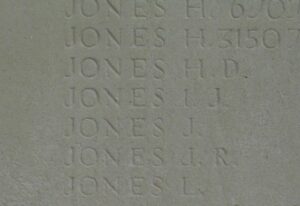
John Harold Jones, Second Lieutenant, Royal Welsh Fusiliers. John was born in 1889, the son of Benjamin C. Jones, and Mary Jones, of 16, Alban Square, Aberaeron. He was commissioned into the 1st Battalion, Royal Welsh Fusiliers, which was in France attached to 22 Brigade, 7th Division. John probably joined the battalion after the Somme Battles of 1916. In March 1917 they followed up the German Retreat to the Hindenburg Line, and took part in Flanking Operations Round Bullecourt. The 7th were moved into a scene of incredible ferocity at Bullecourt, a strongly fortified village on the Hindenburg Line, and alongside the Australians played a major role in penetrating the village defences. Later in the year the Division moved to Ypres, and fought at the Battle of the Polygon Wood. They then took part in the Battle of Broodseinde, the Battle of Poelcapelle and the Second Battle of Passchendaele, suffering terrible losses during Third Ypres, especially in the fighting for Polygon Wood. John was killed at Polygon Wood on 1 October 1917. He was 28 years old, and is commemorated on the Tyne Cot Memorial, Belgium.
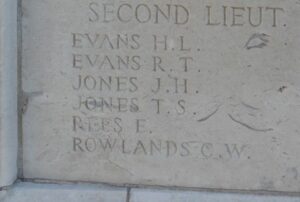
Joseph Sydney Jones, Corporal, 546053, Royal Army Medical Corps. Joseph was the son of Jonathan B. Jones and Anne Jones, of Garth, Aberaeron. Prior to the war he resided with his wife, Winifred Alice Jones, at 346, High Street, Lewisham, London. Joseph enlisted in London into the 2nd London Sanitary Company, Royal Army Medical Corps, and was attached to their 29th Sanitary Section. He served in Egypt during the war, and became ill there due to the terrible conditions. Joseph survived the war and was demobilised on 23 March due to illness. He suffered badly with illness following his demobilisation, and died of sickness in Kent on 5 April 1919, aged 33. He is buried at Lewisham (Ladywell) Cemetery, London. His brother, William Edgar Jones, died in France on 24 October 1918.
Lewis Roberts Jones, Private, 201820, Welsh Regiment. Lewis was born at Aberaeron in 1895, the son of David Rees Jones and Catherine Jones, of 2, Tabernacle Street, Aberaeron. He enlisted at Swansea into the 1/4th Battalion, Welsh Regiment, which was attached to 159 Brigade, 53rd (Welsh) Division. The Division landed at Cape Helles, Gallipoli, on 9 August 1915, and was immediately thrown into action, spending the next few days in isolated pockets, fighting against a Turkish counter-attack during the Battle of Sari Bair, and then at the Attack on Scimitar Hill. The Division remained here throughout the coming months, and suffered severe losses in manpower strength during the great November 1915 blizzard on Gallipoli, when its total strength was reduced to less than that of a full-strength Brigade. On 11 December 1915 the Division was evacuated to Mudros, and by 23 December 1915 were moved to Egypt. They remained on the Suez Canal Defences for the next twelve months, where it took part in operations against the Sultan of Darfur, and in March 1917 took part in the advance into Palestine. Lewis was killed here during the First Battle of Gaza, on 26 March 1917, aged 21. He is commemorated on the Jerusalem Memorial, Israel.
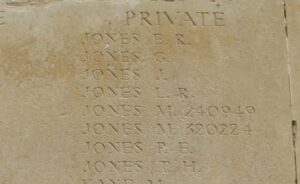
Thomas Enoch Jones, Second Mate, Mercantile Marine. Thomas was the son of Evan and Jane Jones, of Rock Villa, Aberarth. He served with the Mercantile Marine aboard the SS Goathland, a Whitby registered merchant steamer. On 4 July 1917, Goathland was on voyage from St Nazaire to the Gulf of Mexico in ballast, when she was torpedoed and sunk by the German submarine U-84, with the loss of 21 lives. Thomas was 24 years old when he died that day, and is commemorated on the Tower Hill Memorial, London.
Thomas Ireneaus Jones, Sergeant. Sergeant Jones resided at Gwmryn, New Quay, and had been a teacher at New Tredegar prior to the war. He had contracted illness while on service and died at his home on 28 October 1919, aged 29. He is not commemorated by the CWGC, so nothing more is presently known of him.
The Reverend William Edgar Jones, Chaplain 4th Class, Army Chaplains’ Department. William was the son of Jonathan B. Jones and Anne Jones, of Garth, Aberaeron. He served as a Chaplain with the Royal Army Chaplain’s Department, and had served in Salonika from 15 July 1917. Early in 1918, William was posted to the 9th Battalion, Yorkshire Regiment, which was attached to 74 Brigade, 25th Division. The Division had been in France since September 1915, and had fought at Loos. In 1916 it took part in the Somme Offensive, and in 1917 saw action at Third Ypres. The Division took part in heavy fighting during the German Spring Offensives of March and April 1918. After suffering heavy casualties, it was moved to the Aisne, where it saw further heavy fighting during the German offensive of 27 May. The core of the Division returned to England to rebuild, and returned to the front in September 1918, moving at first to St Riquier near Abbeville. Late in the month, it entrained for Fourth Army, coming under XIII Corps, and took part in the advance across Picardy, fighting at the Battle of Beaurevoir. They then fought during the remainder of the great offensive, at the Battle of Cambrai, the Pursuit to the Selle, the Battle of the Selle, and the Battle of the Sambre. William was wounded during the Battle of the Selle, and was evacuated to a Casualty Clearing Station at Roisel, where he died of his wounds on 24 October 1918. He was 30 years old, and is buried at Roisel Communal Cemetery Extension, France. His brother, Joseph Sydney Jones, also fell.
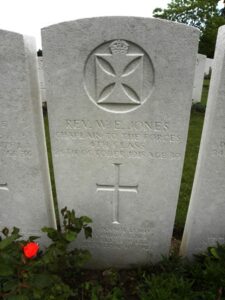
William Timothy Gwynne Jones, Sailor, Mercantile Marine. William was the son of William and Mary Jones, of Penlon Pennant, Aberath. He served with the Mercantile Marine aboard the SS Mersario, a Glasgow registered cargo steamer. On 1 October 1917, Mersario was on voyage from Barry to Italy, carrying a cargo of coal, when she was torpedoed and sunk by the German submarine U-39 with the loss of three lives. William was 22 years old when he died that day, and is commemorated on the Tower Hill Memorial, London.
Charles Guy Patrick, Third Engineer, Mercantile Marine. Charles was born on 8 August 1882, the son of John and Helen Patrick, of the Black Lion Hotel, New Quay. He served with the Mercantile Marine aboard the SS Camellia, a North Shields registered Steamship. Camellia was posted as missing after sailing from Dakar on 27 November 1917 for the United Kingdom. She was presumed to have been torpedoed and sunk by a U-boat on 27 November 1917. Charles was 35 years old when he died, and is commemorated on the Tower Hill Memorial, London.
Henry Loyn Pugh, Second Lieutenant, South Wales Borderers. Henry was born in 1888, the son of Thomas and Mary Pugh, of 7, Alban Square, Aberaeron. Educated at Llandovery prior to the war, Henry became a Councillor, and also a Scoutmaster at Aberaeron prior to his enlistment in the Inns of Court Regiment. He was commissioned into the 3rd Battalion, South Wales Borderers in October 1915. Henry was then attached to the 1st Battalion, South Wales Borderers, which was attached to 3 Brigade, 1st Division, and he arrived in France on 29 August 1916. The Division was on the Somme, and in early September 1916, were in support of the Gloucester’s and Welsh Regiment in the fighting for High Wood. Henry was wounded on 9 September 1916, and evacuated to 36 Casualty Clearing Station at Heilly. Sadly he died of his wounds on 11 September 1916. He was 29 years old, and is buried at Heilly Station Cemetery, Mericourt-L’Abbe, France.
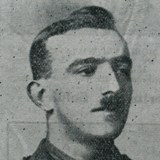
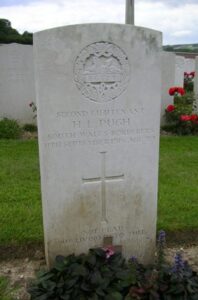
Thomas Gwilym Rees, Second Engineer, Mercantile Marine. Thomas was born in 1885, the son of Joseph and Elizabeth Rees, of 3, Belle Vue Terrace, Aberaeron. He married Mary Morris prior to the war, and the couple resided at Min-afon, Borth-y-Gest, Portmadoc. Thomas served in the Mercantile Marine as an Engineer aboard the SS Paddington, a London registered steamer. On 21 July 1917, she was on route from Cartagena to Britain with Admiralty cargo and passengers, when she was torpedoed and sunk by the German submarine U-96, with the loss of 29 crew. Thomas was among the dead. He was 29 years old, and is commemorated on the Tower Hill Memorial, London.
Evan Lewis Williams, Private, 901, Welsh Guards. Evan was the son of John and Mary Williams, of Frondolau, Aberarth. He lived at Seven Sisters prior to the war and enlisted at Neath into the 1st Battalion, Welsh Guards. The Regiment was raised by Royal Warrant of 26 February 1915, at White City, before landing at Le Havre on 18 August 1915, becoming attached to 3rd Guards Brigade, Guards Division. The Division saw its first major action during the Battle of Loos on 25 September 1915, remaining in the area during the coming months, where they also fought in the subsequent Action of Hohenzollern Redoubt. In July 1916 the Division moved to the Somme, where they fought at the Battle of Flers-Courcelette, and then at the Battle of Morval, capturing Lesboeufs Village. They remained here for the winter, and in the summer of 1917 moved to Ypres, taking up the line on the left flank of the 38th (Welsh) Division. Here the Guards took part in their famous assault on Pilckem Ridge on 31 July 1917. Evan was however wounded during the build up to the battle. He died of his wounds on 28 July 1917, aged 20 and is buried in Dozinghem Military Cemetery, Belgium.
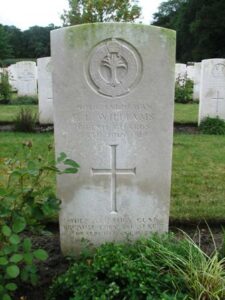
World War Two, 1939-1945
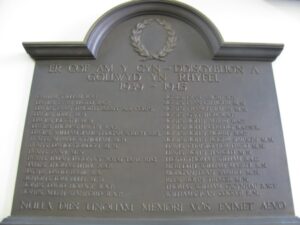
William M. Carter, Flight Sergeant (Pilot), Royal Air Force. William resided at Bronwydd, New Quay. He flew as a Pilot with the Royal Air Force. On 14 January 1944 William failed to return after an operation, and was recorded as missing presumed dead. Nothing more can be traced of him, as he is not commemorated by the CWGC.
Evan Lloyd Davies, Leading Aircraftman, 1412679, Royal Air Force. Evan was the son of Benjamin and Jane Davies, and the husband of Violet Jane Mildred Davies, of Camden Town, London. After the invasion of occupied Europe, Evan was posted to the B.S.R.U. (Base Signals and Radar Unit). On 7 November 1944, Evan was among a large party of RAF servicemen who, along with trucks and supplies for the RAF in Belgium, were aboard the Landing Ship LST-420. It was unable to enter the port of Ostend because of a severe storm and the captain decided to return to England, but hit and mine, split in two, and sank. Fourteen officers and 224 other ranks were lost, with only 31 men saved. Evan was among the dead. He was 34 years old, and is commemorated on the Runnymede Memorial, Surrey.
Evan Timothy Emos Davies, Private, 4209051, Parachute Regiment. Evan was the son of Michael Daniel and Ellen Davies, of Pencwm, Cilcennin. He originally served with the 10th Battalion, Royal Welsh Fusiliers, which was later transformed into the 6th Battalion, Parachute Regiment in August 1942. The battalion embarked for North Africa in April 1943, and took part in the amphibious landings on Italy in September 1943. Evan was aboard HMS Abdiel in Taranto Bay on 10 September 1943, when she struck a mine, and sank with the loss of 57 paratroopers. Evan was among the dead. He was 21 years old, and is buried at Bari War Cemetery, Italy.
Idris Davies, Second Officer, Merchant Navy. Idris was the son of Captain and Mrs. W. B. Davies, of New Quay. He served with the Merchant Navy aboard the SS Barberrys, a London registered cargo ship. On 26 November 1942, she was in convoy SC-110, when she was torpedoed and sunk by the German Submarine U-663, northeast of St. Johns, Newfoundland. Idris was one of 33 lives lost that day. He was 29 years old, and is commemorated on the Tower Hill Memorial, London.
John Islwyn Davies, Chief Steward, Merchant Navy. Islwyn was born at Norland, Aberaeron in 1912. He served for many years prior to the war with the Merchant Navy, and married Mildred Mary Salmon, of Trefine, Pembrokeshire in 1941. John served aboard the S.S. Chulmleigh, a London registered cargo steamer. Chulmleigh had entered service in 1938 and at the outbreak of war was at Colón, Panama, and returned to the UK via the Caribbean. She carried out several long-haul voyages over the next two years, sailing with various convoys in the Atlantic. In September 1942 She moved to Iceland to continue supply work to Russia, in the Arctic Convoys. On 30 October 1942 Chulmleigh left Iceland and headed into the Barents Sea, but ran aground at South Cape, on the main island of Spitzbergen. She was abandoned after being attacked by German aircraft, so her crew took off in her lifeboats, hoping to reach safety at the Norwegian base at Barentsburg. While the crew were trying to row for safety, their ship was torpedoed and sank by the German submarine U-625. Conditions were terrible for the men and they boats became separated when they got caught in a storm on 8 November. John died of hypothermia aboard his lifeboat on 10 November 1942. Two days later some of the survivors reached the safety of Barentsburg. John was 30 years-old when he died. He was buried at sea by his fellow crewmen and is commemorated on the Tower Hill Memorial, London.
Thomas Irwin Davies, Leading Aircraftman, 930988, Royal Air Force Volunteer Reserve. Thomas resided at Aeron Belle, Aberaeron prior to the war, and served with the Royal Air Force Volunteer Reserve. After the invasion of occupied Europe, Thomas was posted to the B.S.R.U. (Base Signals and Radar Unit). On 7 November 1944, Thomas was among a large party of RAF servicemen who, along with trucks and supplies for the RAF in Belgium, were aboard the Landing Ship LST-420. It was unable to enter the port of Ostend because of a severe storm and the captain decided to return to England, but hit and mine, split in two, and sank. Fourteen officers and 224 other ranks were lost, with only 31 men saved. Thomas was among the dead, and he is today buried at Blankenberge Town Cemetery, Belgium.
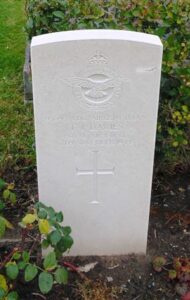
William James Edgar Davies, Lance Corporal, 3976140, Welch Regiment. William, known as Edgar, was the son of David James Davies and Mary Davies, of Penbryn, Hill Street, New Quay, and the husband of Winifred Davies, of Hirwaun, Glamorgan. He served with the 1st Battalion, Welch Regiment throughout the North African campaign. After the Axis forces had been defeated in Tunisia in 1943, the Allies began their liberation of Italy. Edgar was killed in Italy on 1 October 1944. He was 27 years old, and is buried in Cesena War Cemetery, Italy.
Alfred Wyndham Evans, Second Officer, Merchant Navy. Alfred was known as Wyn, and was the son of William David and Catherine Grace Evans, of Golan, Gilfachrheda. He served with the Merchant Navy aboard the S.S. British Sovereign. Wyn was killed while unloading munitions at Abadan, Iran on 3 May 1944, aged 28, and is buried in the English Cemetery at Abadan. He is not commemorated by the CWGC. Thanks to Wyn Edwards for details and the photo of his uncle.
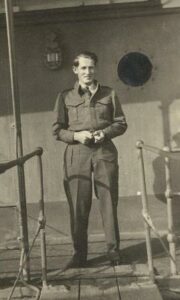
David Gordon Evans, Third Officer, Merchant Navy. David lived at Penbryn, New Quay. He served with the Merchant Navy, aboard the SS Ciscar, a London registered steamer. On 19 August 1941, Ciscar was on voyage from Bristol to Gibraltar when she was torpedoed and sunk by the German submarine U-201, with the loss of 13 lives. David was 26 years old, and is commemorated on the Tower Hill Memorial, London.
Evan Evans, Sailor, Merchant Navy. Evan was the son of Thomas and Margaret Evans, of Llyswen Mill, Aberaeron. He served in the Merchant Navy aboard the SS Empire Tower, a London registered cargo ship. Early in 1943 Empire Tower joined convoy XK-2 from Gibraltar to the UK. On 5 March 1943 the German submarine U-130 attacked the convoy and sank Empire Tower, SS Fidra, SS Ger-y-Bryn and SS Trefusis. Empire Tower sank within a minute, with the loss of her Captain, six gunners and 35 crew. Evan was among the dead. He was 31 years old, and is commemorated on the Tower Hill Memorial, London.
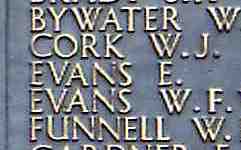
Ieuan Tegonwy Evans, Trooper, 7916893, Royal Armoured Corps. Ieuan was the son of Thomas and Annie Elizabeth Evans, and the husband of Margaret Walkden Evans, of Douglas, Isle of Man. He served with the 44th Royal Tank Regiment, Royal Armoured Corps during the North African campaign. After the Axis forces had been defeated in Tunisia in 1943, the Allies began their liberation of Italy. Ieuan was killed in Italy on 8 November 1943. He was 33 years old, and is buried in Sangro River War Cemetery, Italy.
Thomas Ithel James, Sergeant, 615300, Royal Air Force. Thomas was the son of G. Clifford James and Ellen M. James, of New Quay. He served with 12 Squadron, Royal Air Force, which was a heavy bomber squadron, operating the Avro Lancaster from RAF Wickenby. At around 19.00 on 26 February 1943 Thomas took off from Wickenby aboard Lancaster I, Serial W4792, which was part of a large force despatched to bomb Cologne. The Lancaster was lost at some time on the following morning, on 27 February 1943, with all her crew. Thomas was 22 years old when he was killed that day, and is commemorated on the Runnymede Memorial, Surrey.
David Basil Jayne, Gunner, 862874, Royal Artillery. David was the son of David Francis and Annie Jayne, of Lampeter. He served with 146 Medium Regiment, Royal Artillery, which was the Cardiganshire Battery, and served with the 7th Armoured Division. The battery fought in North Africa and in the invasion of Sicily and Italy before being recalled to Britain, and took part in the Normandy Landings of June 1944. It then took part in the break-out from the Normandy beach-head, and the subsequent drive through Northern France into Belgium and Holland. David was killed during the fighting around the Reichswald Forest on 15 February 1945. He was 22 years old, and is buried at Mierlo War Cemetery, Netherlands.
Tom Ellis Jenkins, Second Officer, Merchant Navy. Tom was the son of Captain Rees Jenkins and Mary Anne Jenkins. He was a Master Mariner in the Merchant Navy, and served aboard the SS Empire Blanda, a London registered cargo steamer. On 18 February 1941, she was on route from Baltimore via Halifax for Grangemouth, carrying a cargo of steel, scrap and explosives, when she was torpedoed by the German submarine U-69 and sunk with the loss of 40 lives. Tom was 37 years old when he died that day, and is commemorated on the Tower Hill Memorial, London.
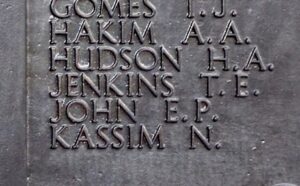
Allen Stanford Jones, Sergeant, 530722, Royal Air Force. Allen was the son of Timothy James Jones and Evelyn Lucy Jones, of Newholme, Aberaeron. He served with 228 Squadron, Royal Air Force. The Squadron was a flying boat squadron in Coastal Command that was equipped with the Short Sunderland. In May 1939 the squadron moved to Alexandria, but at the outbreak of war the squadron returned to Pembroke Dock. Detachments were based at Invergordon and at Sullom Voe, and the squadron flew patrols between Scotland and Norway. In June 1940 Italy entered the war, and in response 228 Squadron returned to the Mediterranean. Most of the squadron was based in Egypt, a detachment operated from Gibraltar, and the squadron used Malta as an advanced base. In October the squadron’s maintenance base was moved from Pembroke Dock to Malta, where it remained until March 1941, carrying out fleet reconnaissance duties and anti-submarine patrols. Allen was killed at Malta on 7 March 1941, during one of the many German air raids on the Island. He was 22 years old, and is buried at Malta (Capuccini) Naval Cemetery.
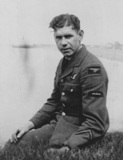
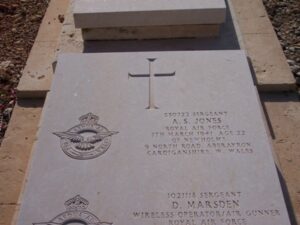
David Horace Jones, Warrant Officer, 1056939, Royal Air Force Volunteer Reserve. David was born on 20 March 1916, the son of Captain John Thomas Jones and Catherine Jane Jones (nee Howells), of 3, Queen Street, Aberaeron. He was educated at Aberaeron County School prior to joining the staff of the National Provincial Bank as a probationer at Lampeter branch in October 1934. He was promoted to clerk in January 1937 and moved to the Cardigan branch a month later, taking up lodgings at 12, Priory Row, Cardigan. In August 1940 he left the bank to enlist into the Royal Air Force Volunteer Reserve and trained as a Pilot before being posted to North Africa. In November 1941 he was taken prisoner and interned in Algeria, however he was freed a year later. After recuperation he became a test pilot, before resuming active service again, joining No. 1697 (Air Despatch Letter Service) flight. On 12 November 1944 David was flying Hurricane IIc, Serial PZ773 from Dijon to Le Bourget when he became caught up in poor weather and crashed into trees on high ground near Molay, killing him instantly. David was 28 years old, and is buried in Choloy War Cemetery, Meurthe-et-Moselle, France.
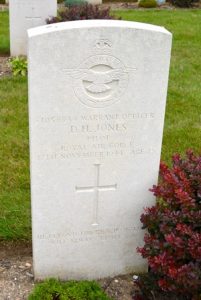
Evan Ancre Jones, Lance Corporal, 2075386, Royal Engineers. Evan was the son of David Jones and of Jane Jones, of Gwastod, Abermeurig. He served with the Royal Engineers in the Mediterranean, and was serving with the British Forces in Greece, during the time of the German invasion of the country. Evan was killed in Greece on 24 April 1941, possibly during the Battle of Thermopylae. He was 22 years old, and is commemorated on the Athens Memorial, Greece.
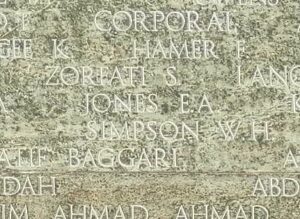
Evan Gilmour Jones, Fifth Engineer Officer, Merchant Navy. Evan was the son of John Lewis Jones and Maggie Lorenzo Jones, of New Quay. He served with the Merchant Navy aboard the MV Inverlee, a Glasgow registered tanker. On 19 October 1941, Inverlee was on route from Trinidad for Glasgow carrying a cargo of fuel oil, when she was torpedoed and sunk by the German Submarine U-204. Evan was one of 21 men lost during the sinking. He was 25 years old, and is commemorated on the Tower Hill Memorial, London.
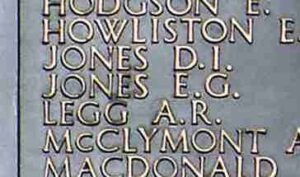
Francis Ieuan Jones, Cadet, Merchant Navy. Francis was born on 19 February 1921, the son of James and Sarah Jones, of Fron Villa, Llanon. He was a cadet with the Merchant Navy, and served aboard the MV Erodona, a London Registered oil tanker. On 15 March 1941, Erodona was in Convoy crossing the Atlantic when she was hit by a torpedo from the German submarine U-110. The ship managed to limp back to port, but Francis was among 36 men killed during the explosion of the torpedo that day. He was 20 years old, and is commemorated on the Tower Hill Memorial, London.
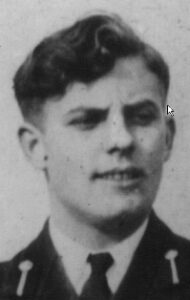
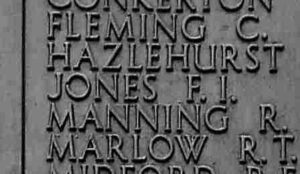
Jack Rogers Simpson Jones, Sailor, Merchant Navy. Jack was the son of Evan and Margaretta Mary Jones, of New Quay. He served with the Merchant Navy aboard the SS Beechwood, a London registered Steamer. On 26 August 1940, she was on route from Haifa to Britain carrying a cargo of general freight and potash, when she was torpedoed and sunk by the German submarine U-130. Jack survived the sinking, but died at New Quay as a result of injuries suffered, on 15 August 1945. He was 22 years old, and is buried at New Quay New Cemetery.
John Albert Jones, Flight Sergeant, 1022998, Royal Air Force Volunteer Reserve. John was the son of Thomas Edward and Anne Jones, of Pontfaen, Ciliau Aeron. He served as a Wireless Operator/ Air Gunner with 51 Squadron, Royal Air Force, which after 1942 was equipped with the Halifax bomber. On the morning of 18 December 1944, John took off from RAF Snaith aboard Halifax BIII, Serial NR248 as part of a large number of aircraft despatched to bomb Duisburg. The Halifax was shot down and crashed near Broekhuizenvorst, with the loss of six of seven of its crew. John was 23 years old when he was killed during the crash on 18 December 1944. He is buried alongside his fellow crew-men in Venray War Cemetery, Netherlands. There is a memorial to the crew at the crash site outside Broekhuizenvorst.
John Ceredig Jones, Sergeant, 1386043, Royal Air Force Volunteer Reserve. John was the son of John and Ellen Jones, of Parc, Nebo, Llanon. He enlisted into the Royal Air Force Volunteer Reserve and after completing his training as an Observer was posted to 158 Squadron, Royal Air Force, which was a bomber squadron, equipped with the Halifax Mk II. On the night of 3 April 1943 John took off from RAF Lissett aboard Avro Halifax DT795, which was part of a large bomber force bound for strategic targets in Essen. Just hours into the flight John’s Halifax was intercepted and shot down by a German night fighter, piloted by Unterofficer E. Heinzelmann, and crashed into the Apeldoorn Canal at Wapenveld, near Heerde. The bodies of three of her crew were recovered from the canal and were buried at Amersfoort, while John, who was 31 years old, and three other crew had no grave as their remains were trapped in the wreck of their aircraft. John was originally commemorated with his comrades on the Runnymede Memorial, Surrey, but in 2016 the men’s remains were found in Holland and were exhumed before being interred in Wapenveld General Cemetery, near Heerde. John’s headstone has the personal inscription: ‘YN COFIO MEWN HIRAETH A CHYDA DIOLCH AM UN A FU FARW DROS GYD-DDYN A’I WLAD’. (Photo courtesy of Robin Hill).
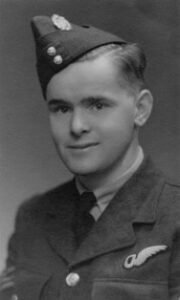
John Morris Jones, Sergeant, 650138, Royal Air Force. John was the son of John Oswald Jones and Achsa Ellen Jones, of Tiresgob, Synod Inn. He served with 467 Squadron, Royal Air Force, which was a heavy bomber squadron, equipped with the Avro Lancaster. The squadron took part in all the major Bomber Command campaigns against Germany and German-occupied Europe; the Ruhr, Hamburg, and Berlin, and took part in the first shuttle-bombing raids when, after attacking Friedrichshafen on 20/21 June 1943, it flew to North Africa and on the return flight bombed Spezia, the home of the Italian Navy. Just before 21.00 on 23 August 1943 John took off from RAF Bottesford aboard Lancaster III, Serial JB124, which had been despatched as part of a large force to bomb Berlin. The Lancaster failed to return the following day and all of her crew of seven were recorded as missing presumed killed. John was 29 years old and is commemorated on the Runnymede Memorial, Surrey.
Owain Gwynfor Jones, Flight Sergeant (Pilot), 570249, Royal Air Force. Owain was the son of John Owen and Margaret Eleanor Jones, of Llanarth. He served as a Pilot with 112 Squadron, Royal Air Force, which was based in Sicily after the invasion of the Island on 10 July 1943, operating the Curtiss P40-Kittyhawk. In February 1945 the Squadron converted to the Mustang MkIV, and supported the ground assault troops in the Italian Campaign. Owain was shot down in the Adriatic and had to parachute out of his Mustang III, Serial HB925 on 21 October 1944. He was picked up by a Catalina and brought to hospital. He soon recovered and was back in the air again. Sadly, Owain was killed when his aeroplane crashed during operations over Italy on 11 March 1945. He was 25 years old, and is buried at Padua War Cemetery, Italy.
Christopher David Lewis, Master, Merchant Navy. Christopher was the son of Owen and Sarah Peers Lewis. He lived with his wife, Belva Margaret Williams Lewis, at The Mount, Llanon prior to the war, and served in the Merchant Navy as Master of the SS Stanburn, a London registered steamer. On 29 January 1940, Stanburn was south-east of Flamborough Head, when she was attacked by a German Stuka dive-bomber, and was struck by three bombs, which sank her. Reports stated that around twenty survivors took to the life boats, but were machine-gunned by the Stuka. Christopher, and twenty-five of his crew were killed in the attack, there were only three survivors. Four bodies were later washed ashore, one being identified as Christopher. He was 40 years old, and was buried at Llansantffread (St. Bridget) Churchyard, Ceredigion.
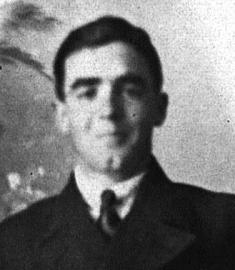
John Harold Lewis, Third Officer, Merchant Navy. John was the son of Harold and Elizabeth Lewis, of Melbourne, Aberaeron. He served with the Merchant Navy, aboard the MV Corbis, a London registered tanker. On 18 April 1943, she was on route from Abadan for Table Bay, carrying a cargo of 13,100 tons of diesel oil and 50 tons of aviation spirit, when she was torpedoed and sunk by the German submarine U-180. Fifty of her crew of sixty were killed. The CWGC records show that John died on 29 April 1943- 11 days later. John was 23 years old, and is commemorated on the Tower Hill Memorial, London.
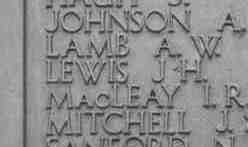
Thomas William Lloyd, Trooper, 14497632, Royal Armoured Corps. Thomas was the son of John and Ann Lloyd, of 8, Water Street, Aberaeron. He served with the Royal Armoured Corps. Nothing further is yet known of Thomas’s service, but he died at Swansea on 25 January 1944, aged just 18. Thomas is buried at Henfynyw (St. David) Churchyard, Ceredigion.
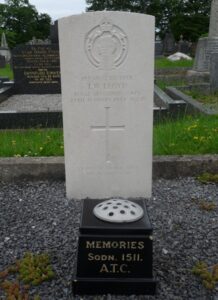
William Maskell Meredith, B.A., Able Seaman, P/JX 259799, Royal Navy. William was the son of George Edwin and Margaret Helen Meredith, of Ffairfach, Carmarthenshire. He had been a staff member at Aberaeron Secondary School from 1 October 1939 until 31 March 1941, when he enlisted into the Royal Navy, and served as a Radio Location Officer aboard the light cruiser HMS Arethusa. She was taking part in the famous Malta Convoy on 18 November 1942, when she was struck by a torpedo from an Italian submarine, which caused heavy casualties. Arethusa managed to limp to Alexandria for repairs, and served for the duration of the war after a full overhaul at Charleston Naval Yard, South Carolina. William was 27 years old when he died during the attack of 18 November 1942, and he is commemorated on the Portsmouth Naval Memorial, Hampshire.
Evan Samuel Morgan, Able Seaman, P/JX 252993, Royal Navy. Evan was the son of Daniel James and Jane Morgan, of Gwel-y-Don, Aberaeron. He married Violet Winifred Laura Pearce, of Stanmore, Middlesex, in 1932. Evan served with the Royal Navy during the war, and had been attached to HMS Excellent II. He was killed during the landings at Augusta, Sicily on 29 July 1942, aged 37. Evan served as Sydney for some reason, and is commemorated under that name on the Portsmouth Naval Memorial, Hampshire.
John Trevor Rees, Cadet, Merchant Navy. John was the son of Evan David Rees and Eleanor Linda Rees, of New Quay. He served with the Merchant Navy aboard the SS Beaverford, a London registered cargo ship. On 5 November 1940, Beaverford was part of Convoy HX-84, when it was attacked by the German Battlecruiser Admiral Scheer. Grossly outgunned, the Convoy suffered terribly, losing its escort destroyer, HMS Jervis Bay, before Admiral Scheer turned its attention to the Convoy, sinking seven ships. Beaverford went down with all her crew of 77. John was 19 years old, and is commemorated on the Tower Hill Memorial, London.
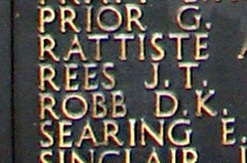
Gwyndaf Thomas, Serjeant, 4196335, Royal Welch Fusiliers. Gwyndaf was the son of William Rees and Mary Ellen Thomas, of New Quay. He served with the 2nd Battalion, Royal Welch Fusiliers. The Battalion left the UK in February 1942 and sailed for Madagascar to capture the Naval Base of Diego Suarez, which was a French Naval Base that had been taken over by the Japanese, and garrisoned by Vichy French troops. Gwyndaf was killed during the ensuing fighting, on 6 May 1942, aged 22, and is buried at Diego Suarez War Cemetery, Madagascar.
Ivan Cooper Williams, Ordinary Telegraphist, P/JX 299248, Royal Navy. Ivan was born on 12 July 1921, the son of William Lewis Williams, Master Mariner and Margaret Bennett Williams, of Belle Vue Bungalow, Aberaeron. He served with the Royal Navy, and was based at HMS Drake, the Royal Naval Base at Plymouth. Ivan became ill whilst serving in Plymouth and was hospitalised where he was diagnosed as suffering from tuberculosis. He died of tuberculosis at Aberaeron on 13 September 1943. Ivan was 22 years old, and is buried at Henfynyw (St. David) Churchyard, Ceredigion.